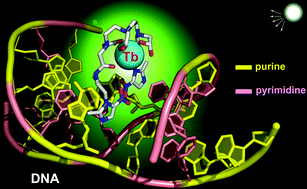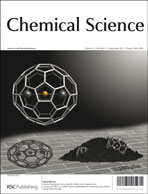Specific recognition of DNA depurination by a luminescent terbium(iii) complex†
Abstract
Recognition of DNA depurination is of great importance for early cancer detection. Current analytical methods for this purpose are usually complicated. Luminescent lanthanide complexes possess some fascinating optical properties that have shown potential applications in biomedical research. In this study, a novel terbium(III) complex (TbL) has been demonstrated to be capable of recognizing purine nucleobases in DNA as a selective time-resolved luminescence probe. TbL consists of a luminescent terbium(III) center and two nitroimidazole groups linked by a linear polydentate ligand. The luminescence of TbL is enhanced remarkably upon reaction with oligonucleotides or natural DNA containing purine bases in aqueous solution, while it is quenched dramatically as depurination occurs to DNA. Mechanistic studies using circular dichroism and fluorescence spectroscopies reveal that the luminescence enhancement results from the preferential intercalation between the nitroimidazole moieties of TbL and the purine bases of DNA, which regulate the electron withdrawing effect of nitro groups via hydrogen bonds and thereby affect the energy transfer from the ligand to the metal center of the probe. This mechanism is also supported by molecular dynamics simulation results for the reaction. The distinct luminescence responses of TbL in the presence and absence of purine bases in DNA make it a sensitive probe for DNA depurination in physiological conditions.

- This article is part of the themed collection: Chemical Biology

 Please wait while we load your content...
Please wait while we load your content...